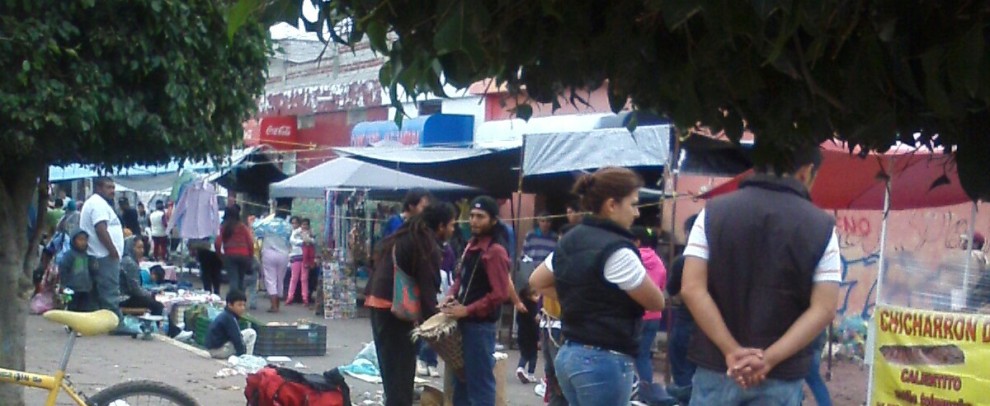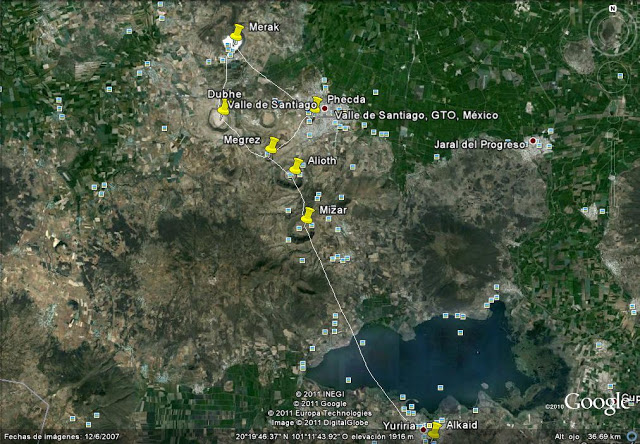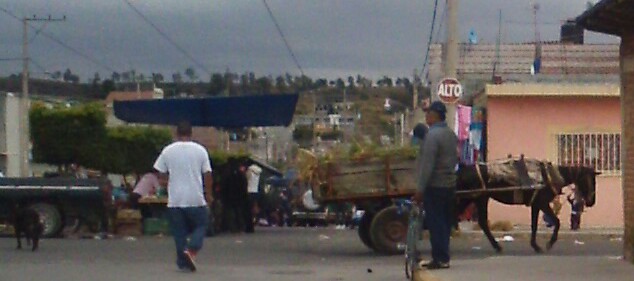 The other week we headed to the town on the other side of the Lake Yuriria, Valle de Santiago. The town itself doesn’t have any of the magic that Yuriria or Cuitzeo have, but what it does have is a kick-ass tianguis (flea market) on Sunday. We were able to buy two pairs of Levi’s jeans for my son, a pair of Dockers Corduroy Pants and Caterpillar Work Boots for my husband and a Spider Plant
The other week we headed to the town on the other side of the Lake Yuriria, Valle de Santiago. The town itself doesn’t have any of the magic that Yuriria or Cuitzeo have, but what it does have is a kick-ass tianguis (flea market) on Sunday. We were able to buy two pairs of Levi’s jeans for my son, a pair of Dockers Corduroy Pants and Caterpillar Work Boots for my husband and a Spider Plant
for me, all at totally reasonable prices. AND since we had to go through Yuriria to get to Valle de Santiago, we stopped for a fabulous lunch in el mercado (market). Since the weather had turned chilly, I had an excuse to purchase my first ever rebozo. Wearing a rebozo is like wearing a blanket–and totally acceptable in public. My husband and son called me granny the rest of the day, but I was a warm granny!
So a little history here…
Valle de Santiago and the surrounding area was first settled about 2,000 years ago by the Purepechas and most likely conquered or otherwise absorbed by the Tarascos. Back then it was called Kamenbarhu (or Camembaro) which translates as roughly “lugar del estafiate” which then translates as “place of the estafiate plant.” Estafiate is also known as Western Mugwort, Western Wormwood, Louisiana Sagewort, Prairie Sagewort, Mountain Sage, Simonillo, and Itzauhyatl in Nahuatl and is used for digestive issues, as an analgesic, a decongestant, a sedative, a diuretic, an expectorant and an antioxidant, among other uses.
Kamenbarhu (or Camembaro) was renamed Valle de Santiago (Saint James’ Valley) and officially “founded” in 1607 by a bunch of Spaniards. In 1997, the state of Guanajuato declared the area a natural preserve.

Valle de Santiago
While the town of Valle de Santiago isn’t much to brag about–the drive there and back is spectacular. We already knew that Lake Yuriria is formed from an extinct volcano crater, so it was not much of a stretch of the imagination to see that the surrounding landscape also had a volcanic look to it. When we got home, I did some internet research–because asking the locals never gets us anywhere–and lo and behold, the area all around Valle de Santiago is known as the Siete Luminarias (7 lights) which refer to 7 distinct craters, although there are more than 30 craters formed by now extinct volcanoes in the immediate area.
Astroarchaeology (the study of how people have understood the phenomena in the sky and the role that understanding played in their culture) suggests that the Siete Luminarias align with the constellation La Osa Mayor (the Big Dipper) every 1040 or 40,000 years (there seemed to be a bit of a discrepancy on when that event actually happens) hence the name Siete Luminarias. It does appear to make the rough outline of the Big Dipper if you look at the map below.
The 7 craters are named as follows:
La Alberca, formerly known as Tallacua
Hoya del Rincon de Parangueo, formerly known as Liricua
Hoya de Flores, formerly known as Membereca
Hoya de Cintora, formerly known as Andaracua
Hoya de San Nicolas
Hoya de Alvarez
Several of these craters have been the site of strange phenomenon. The lake in the Hoya de San Nicolas turns red, much like Lake Yuririra does, and probably for the same reason.
La Alberca is reportedly home to Chac (or Chan), the Loch Ness monster’s cousin. This creature is said to live in the underground tunnels that connect the craters. It supposedly resembles a sauropod dinosaur.The only picture of the creature was taken in 1956 from a plane, and it seems far from conclusive to me. But maybe you want to believe????
There have even been various reports of extraterrestrial contact and UFO sitings in the area of the Hoya de Flores. A local resident riding his donkey saw strange lights in 1987. Crop circles were later discovered in the area (although I haven’t been able to find any pictures of them online.) Some UFO-ologists reported contact with a glowing silvery-blue man there. The most famous contact was with a local farmer, Jose Carmen Garcia Martinez, who grew enormous vegetables in La Hoya de Flores in the 1970s. He claimed that his astronomical success in creating his astronomical sized vegetables was based on agricultural methods he received from astral messages.
Well, I wouldn’t have expected aliens and monsters from our pleasant day in Valle…but then I have learned that Mexico is often not what it appears to be.
******************************************







